
Morgan - 23-5-2015 at 09:52
So I was toying with some propane pop guns and accidentally discovered something kind of different. There were a few videos I watched which seemed fun
for their simplicity and these got me started.
DIY: 2 Liter Propane Pop Gun
https://www.youtube.com/watch?v=jXoqw-_uDx4
Propane Rifle
https://www.youtube.com/watch?v=IApUK_eu3Ek
One thing on hand were some empty aluminum beer bottles used for some previous experiments so these were what I chose because they were cheap and
simple too. The first gun constructed was 16 ounce aluminum beer bottle that happened to press fit nicely into a piece of metal conduit pipe with a
bit of elbow grease. It's so loud you really don't want to fire it without hearing protection, as seemingly innocuous as it looks.
Later the next day it occurred to me the dollar store mini bundles of steel wool I had purchased might catch fire and make a good light show in the
dark if fired from the rifle. So that worked fairly well, rolling one of the steel wool rolls from the pack into a somewhat dense ball and ramming it
down the barrel. The glowing fireball shoots about 60 feet and plops down hitting the grass most of it still intact but also many glowing fragments
clustering near it making a shower of sparks raining down just before it strikes the lawn about 8 feet up in the air, as drag finally takes over and
pieces of the wool break away from the main body. I feel sure the effect could be perfected with some thought.
The one thing about using a propane torch and piezo ignition is that the device, whatever it is, must allow the propane and entrained air to flow
freely or enough so that the fuel/air mixture fills the device - no solid obstructions. But in that caveat, it's amazing is how effortless this mixing
effect works to your advantage.
Then I tried press fitting/sleeving two bottles together end-to-end after first cutting the bottoms off of both. One end was first expanded by
pressing it over the top of an uncut bottle. This arrangement would sometimes fire with enough force to blast one of the bottles about thirty feet
downrange, even though the gases could freely escape out the opening of the bottle neck. In the other end of this two bottle arrangement a short
length of vinyl tubing was press fit in the other open end. It seems there's something about impedance matching that comes into play, how having a
length of tubing in front of the chamber helps the cascade of events to play out more ideally. Likewise if you make the barrel of the gun too long,
you lose some of the suddenness or energy. The vinyl tubing was the same diameter as used in the Nighthawkinlight demonstration, purchased at Home
Depot or Lowe's.
I can't figure out how or what's going on in this next example but the effect is insanely loud. It comes to mind how the barking dog builds feedback,
slinging the air in opposite directions many times a second as seen in the slow motion videos, mixing or exciting the gases?
So here is the scenario. A narrow 12 ounce Red Bull can I found on the ground one day while walking looked unblemished so I took it home with me for
some possible future use. These types of cans glide easily inside of a 16 ounce aluminum beer bottle. If you place one in an inverted beer bottle with
the bottom cut off, the can floats softly down until strikes the necked region. The Red Bull can has one pop top open end but none on the bottom to
allow for fuel/air ratio to permeate the can if placed in the beer bottle. The idea was to somewhat mortar the Red Bull can out of the beer bottle but
that didn't happen!
To allow for the propane/air mixture to fill the can I first melted a small hole roughly a centimeter in diameter in the bottom of the Red Bull can
using a different torch with a pointy flame. I could have drilled a hole or punched one out I guess but the flame melting a hole was a very fast
method that just occurred to me as I decided the other options more work.
A few minutes ago I tried filling the Red Bull can with propane and air from the torch and lighting it. Hot gases whistled out both ends and even if
it were just one opening the effect would probably be the same - a deflagration of sorts. Or perhaps if completely sealed and sparked the flame front
wouldn't advance that fast. But when placed as such with the holes at opposite ends and inside the open-ended beer bottle and length of vinyl tubing
connected to the torch, a magnificent explosion occurs, the kind that echoes off your house and throughout the neighborhood. The Red Bull projectile
flew away high in the air. Upon recovery and examination the bottom of the can had deformed significantly.
What's odd is how the hot gases don't have time to escape and it really has to be witnessed to be appreciated, the amount of sound for so small a
volume and of seemingly meager confinement. I guess that's what happens when conditions are right. Is it some sort of hammer wave or sudden to and fro
spinning and mixing that's the cause or what? I think of water how soft it is but very hard if you happen to hit it at a high speed. I remember
placing a piece of cardboard over one end of a pulsejet with the head removed. It doesn't take a lot of force for the bark to occur, just the least
amount of obstructing mass is enough for a loud bark to propagate if the cardboard can't get out of the way fast enough or such that a blockage is
sensed.
Anyway the featherlight Red Bull aluminum can effect is much louder than the beer bottle pop gun pictured below, which I can't stand to fire without
wearing hearing protection. I forgot to mention the intake of the pop gun is a 3/8 inch plumbing pipe nipple 3 inches long held on with a conduit nut
on either side of the beer bottle wall.
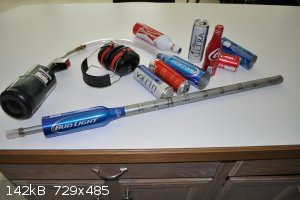
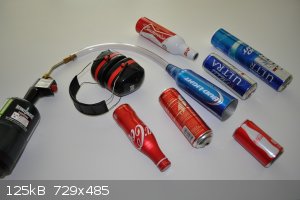
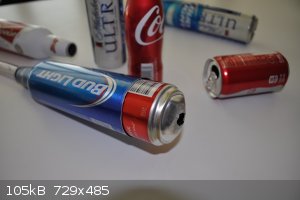
violet sin - 23-5-2015 at 10:25
wow, I like the idea and linked vids! seems like you could make something just for showy blue traces, loud reports or projectile fun.. pretty
versatile. thanks for sharing
Morgan - 23-5-2015 at 10:45
Here's a few more stills and another arrangement I tried. If the bottles aren't carefully sleeved tightly they break apart with a loud bang and one
flies off downrange. You wouldn't think that would happen with the large hole for an exhaust though - even on the ones without a barrel attached. In
one photo I am about to fire one can as a projectile for fun.
Again, that Red Bull can within the open-ended Bud Light bottle and short length of vinyl tubing is one of the loudest party poppers for so simple and
frail a vessel, you'd almost think it was using pure oxygen. I love accidental discoveries like this. Probably you should wear eye protection too, the
sound is uncanny.
I just wonder what the physics of it is, how the flame front starts to escape out the two holes if that or if the flame initially darts through the
center of the can lighting it all at once?
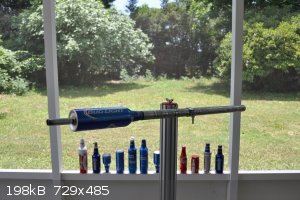
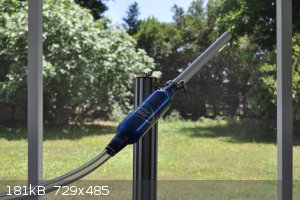
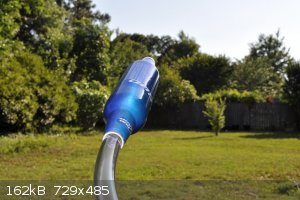
[Edited on 23-5-2015 by Morgan]
Zombie - 23-5-2015 at 11:11
My neighbors are going to LOVE you.
I'm painting links to this thread on all my beer bottles.
Expect much abuse. 
Pumukli - 23-5-2015 at 11:36
Several years ago I studied the propane guns farmers use to deter animals. That time I found a book somewhere on the net which was freely available
after registration where they asked a few questions about you and your intent. (It was after 9/11)
I remember that in that book I read that the speed of burning of propane/air mixtures can be very different depending on the power of initiation. If
you just "light" the mixture with a not too energetic flame (spark) then it burns and bangs and such.
But if you make a small, somewhat confined area somewhere in a bigger unconfined space (or attached to it) and you put the starting spark plug
(initiation) into that confined space then the following happens: the spark lights the fuel/air mixture and it burns at the "usual" (relatively slow)
rate. Then the flame front reaches the walls of the confinement and "snaps" out from it (it must be not a fully closed space, there must be holes)
with a powerful "flame blast". Then this much more powerfull "micro flame blast" ignites the mixture in the chamber and it produces a much quicker
burning (and a loud bang). I think the explanation was centered around the produced strong flame turbulence when it snaps out from the confined
initiation chamber.
What if the plastic tube acts as an initiation chamber?
Zombie - 23-5-2015 at 11:42
LOLOLOLOL, A two stage hell raiser. I LOVE it.
Having built race engines for 40 some years I completely understand the concept you posted Pumukli.
It's what would be referred to as a pre-combustion chamber in any race engine worth it's salt, and the increase in power does not need to be measured.
It is felt.
I Like Dots - 23-5-2015 at 18:45
Hey Morgan, glad you like the rifle. Im "TheBackyardScientist" by the way! I like what you have done with the concept! 
Morgan - 24-5-2015 at 06:17
Hi I Like Dots, that was clever the way you got around the refueling of a potato gun problem, getting the fuel/air mixture to flow by letting it skirt
around the golfball - elegantly simple.
I was surprised the Red Bull can (even with a hole in the top and bottom) placed inside the Bud Light bottle would actually get pushed out from the
feeble pressure of the propane torch when I was fueling it. But there's not much friction and the can is very light. So I had to just barely pull the
trigger and re-release it to charge the arrangement.
I thought about trying a one-way flap valve at the back of a pop gun that would swing open on the low pressure phase from the vacuum created after the
hot gases and projectile ejected from the barrel. This is sort of how a pulsejet works, the little Dyna-jet for example "Red Bulling" 240 times a
second.
Here's a closeup of that Red Bull can, how the concave bottom became convex from the pressure. Oddly the top of the can with the pop-top opening
wasn't deformed, but the unaltered pop-top hole is larger than the one I put in the bottom.
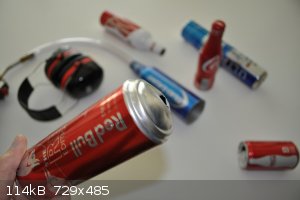
[Edited on 24-5-2015 by Morgan]
Morgan - 24-5-2015 at 09:19
I was thinking if you melted some KNO3 and sugar and formed it into a balll, that might be fun to fire out of a propane pop gun Roman candle style. I
remember making some marble-sized ones that spun around on the pavement then took to the air flying about erratically when they burned down to be
light enough. Little chips leftover from the melt were neat when lit from a spoon, orbiting and zipping about until finally vanishing in a wisp of
smoke.
Morgan - 24-5-2015 at 13:30
Pumukli, thanks for that bit of information. I remember experimenting with a small jam jar jet of sorts with a snorkel attached hoping it would
sustain in a typical fluttering in/out breathing manner. But instead it just went off like a gunshot. I suspect that it was due to an oilcan effect
where the shape was allowed to flex instead of being a completely stiff container. What it was in fact was an oilcan, the kind you actuate using your
thumb. A plumbing pipe bell reducer happened to match the threads where the narrow spout screwed on so I was able to neck the small oilcan with the
reducer and short length of tubing of the size I wanted. After spritzing it with methanol and lighting the only port it had, the single snorkel that
was supposed to be the intake and exhaust, as tiny as the can was, it really went bang, no rev up, no pause, just an instant gunshot when lighting the
tip of the exhaust end.
Morgan - 25-5-2015 at 11:23
Here's a couple of the aluminum beer bottle pop guns. No bells or whistles but they were simple to make.
Propane Pop Gun Using a Beer Bottle
https://www.youtube.com/watch?v=nfS86Y0i92M
Propane Pop Gun Toy
https://www.youtube.com/watch?v=hYk3FyCsRWg


